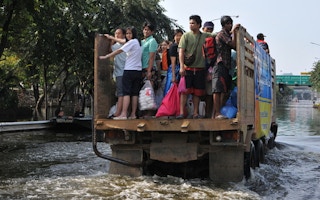Humanity is on the move. We are living in an era of unprecedented mobility of ideas, money, and, increasingly, people.
The sheer size of the human population, combined with how we consume resources, is profoundly reshaping our world. While our “take-make-dispose” economic model has created wealth for hundreds of millions of people in many countries, reducing global poverty significantly, it has also left too many behind. Crucially, it exposes future generations to immense social, economic, and environmental risks. And perhaps the most important risk stems from filling the atmosphere with greenhouse gases at a rate higher than at any time in the last 66 million years.
One billion people alive today are migrants, having moved within or beyond their national borders. They have done so for a variety of complex reasons, including population pressure, a lack of economic opportunities, environmental degradation, and new forms of travel. Combined, these factors are contributing to human displacement and unsafe migration on an unprecedented scale. And the levels of both will only rise as the effects of climate change gradually erode millions of people’s livelihoods.
Climate change is fundamentally redrawing the map of where people can live. Food supplies are being disrupted in North Africa’s Sahel region and Central America; and water stress and scarcity are growing worse in North Africa and the Middle East. Somalia, for example, is experiencing more frequent droughts. Iraq is battling more frequent heat waves. Unprecedented storms and floods have battered the Caribbean and Gulf of Mexico. As the abnormal becomes the new normal, scarcities, zero-sum competition, and mass displacements will become more common.
“
“Climate change and environmental degradation are creating unacceptable levels of human insecurity.”
But there is good news to report on two fronts. First, we are making major strides in building resilience to extreme weather. In the 1970s, Bangladesh lost hundreds of thousands of people to extreme flooding. Today, the fatalities from similar occurrences, while no less tragic, are far fewer in number. We are getting better at coping with disasters.
Second, for the first time in history, the international community is coming together to build a framework to manage international migration. Intergovernmental negotiations started in February 2018 with the aim of adopting a Global Compact for Safe, Orderly, and Regular Migration (GCM). And last month, the United Nations General Assembly finalised the GCM, which heads of state are now expected to adopt at a high-level conference in Marrakesh this December.
The GCM promises to provide a sound framework for taking action that addresses climate-driven migration. But now we must ensure that it is implemented. The GCM represents a once-in-a-generation opportunity to set in place an internationally-agreed system for managing safe and orderly migration. As such, it has the potential to improve the lives and prospects of tens of millions of people. Once it is formally adopted, we will need to ensure that the new framework maximises the benefits of international travel and exchange, while also addressing the concerns that many people have with unregulated migration.
Finally, and most important, we will have to do everything possible to reduce greenhouse-gas emissions drastically. That is the only way to keep the Earth’s temperature within 2°C of pre-industrial levels—the threshold at which spiraling feedback loops could trigger runaway climate change.
The recent report that atmospheric carbon dioxide now exceeds 410 parts per million should serve as a wake-up call. We urgently need to become more resource-efficient, by adopting sustainable consumption and production methods, and by fundamentally altering our economic model.
The window for action is quickly closing. Climate change and environmental degradation are creating unacceptable levels of human insecurity. If our environment is sustainably managed, we will have a better chance of upholding migrants’ dignity, rights, and prospects.
These two goals are inseparable, and the organisations that we lead are ready to support the efforts of the world’s governments to achieve them. The year 2018 presents us with a unique opportunity to think and plan for the decades ahead, by stepping up action on both migration and the environment.
As we set in place a framework to provide for safe, regular, and orderly migration, we must harness our creativity to address its causes. Above all, we need far-sighted world’s leaders with the will to fix a problem that is already upon us, and that is entirely of our own making.
Erik Solheim is executive director of the United Nations Environment Programme. William Lacy Swing is director general of the United Nations Migration Agency.
Copyright: Project Syndicate, 2018.



















